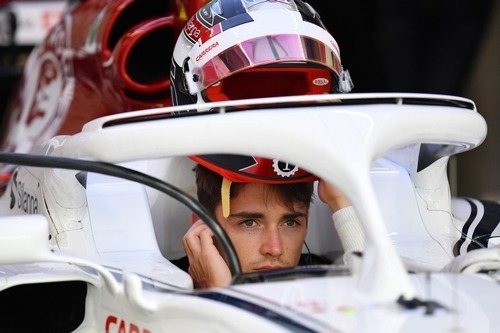
While his race came to a depressing early end, Charles Leclerc was certainly lucky to escape injury in the first lap drama at the 2018 Belgian Grand Prix. Many have credited this luck to the highly controversial Halo device, but I have my doubts.
The incident in question was a result of a braking error by Nico Hülkenberg, who rear-ended Fernando Alonso’s McLaren into turn one. Alonso’s out of control car flew over the top of Charles Leclerc’s Sauber. Everyone walked away from the crash, but it was a situation similar to the big crash in 2012 at the same spot.

The media has been quick so show photos of Leclerc’s car with the Halo blacked by tyre marks, claiming that the device saved Leclerc from injury. There has also been some slow-motion footage of the accident from Pierre Gasly’s point of view, claiming to show the Halo at work. There is no doubt that the Halo did its job and blocked the tyre from hitting Leclerc’s helmet, but I’m not convinced that the result would have been any different without the Halo.
Obviously, it’s a point that’s difficult to prove given that we can’t accurately predict the outcome of something that didn’t happen. However, a racing helmet is specifically designed to withstand strong impacts, so there is no reason that it wouldn’t have been fine without the Halo. That’s why the drivers where the helmets after all.
In addition, the driver’s head is extremely well restrained, as it’s supposed to be, protecting against injury from impact with the helmet. Other safety features, like the raised cockpit around the side of their head, that would have also provided ample protection without the Halo. These devices on their own have provided protection to drivers involved in similar accidents during the pre-Halo era, so there’s no proof that they wouldn’t have done so in this case as well.
At the end of the day, the most important thing is that Leclerc is ok. There are a million of other outcomes that could have been a lot worse for Leclerc, but he was fortunate to get the outcome that he got.
There are still a lot of anti-Halo fans out there, mainly arguing the appearance of the Halo. I myself didn’t support the introduction of the Halo, although my reasoning was mainly arguing the lack of research that was put into the device prior to the introduction because the entire project seemed rushed. I still feel that there wasn’t enough research done. I didn’t care much for the appearance, although it admittedly is not as bad as I imagined and it has been pretty easy to adjust to it.
Nevertheless, every accident is a little different. There are a million factors at play that impact the outcome of the situation. There are undoubtably situations where the Halo would have been helpful, like in the case of Henry Surtees for example, but there are also cases in which it wouldn’t have mattered either way, like for Jules Bianchi or Felipe Massa for example. There have also been scary situations, like Michael Schumacher in Abu Dhabi in 2010, in which everyone was fine without the Halo.
While the Halo certainly didn’t hurt in this situation, I think it’s foolish to credit it for this particular situation and claim that it “saved” Leclerc because I have my doubts that it did. I don’t agree with glorifying the device in this way.
The views and opinions expressed in this article are solely those of the author and do not necessarily reflect the official policy or position of any other agency, organization, employer or company. Assumptions made in any analysis contained within this article are not reflective of the position of any entity other than the author.